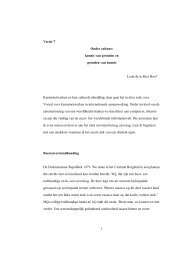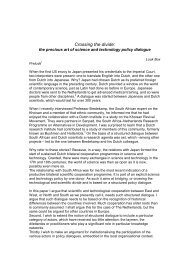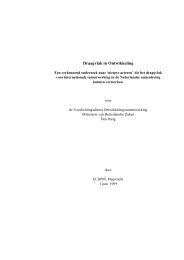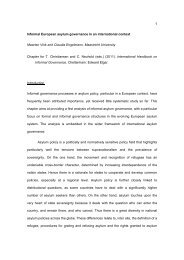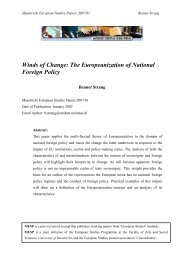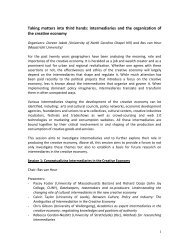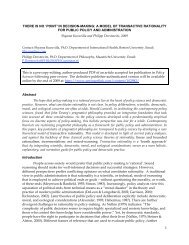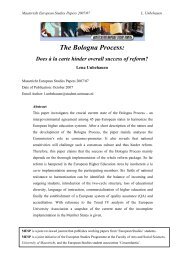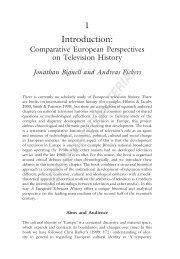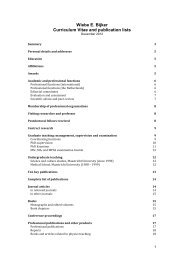the case of the synthetic dye industry, 1857–1914 - Maastricht ...
the case of the synthetic dye industry, 1857–1914 - Maastricht ...
the case of the synthetic dye industry, 1857–1914 - Maastricht ...
Create successful ePaper yourself
Turn your PDF publications into a flip-book with our unique Google optimized e-Paper software.
178 J.P. Murmann and E. Homburg<br />
1 Introduction<br />
Empirical investigations <strong>of</strong> <strong>the</strong> evolution <strong>of</strong> <strong>industry</strong> have flourished over <strong>the</strong> last<br />
two decades. But with <strong>the</strong> exception <strong>of</strong> Carroll and Hannan’s automobile study<br />
(1995) and to some degree Chesbrough’s (1999) work on <strong>the</strong> hard drive <strong>industry</strong>,<br />
no one has examined in a systematic fashion whe<strong>the</strong>r evolutionary patterns are<br />
<strong>the</strong> same in different social contexts (see Carroll and Hannan, 2000, for a survey).<br />
The goal <strong>of</strong> this paper is to present some striking dissimilarities in patterns <strong>of</strong><br />
evolution that appear when <strong>the</strong> level <strong>of</strong> analysis is not <strong>the</strong> global level, but ra<strong>the</strong>r<br />
individual countries. These variations in country patterns raise questions about<br />
current models <strong>of</strong> industrial evolution and call out for an explanation. Based on<br />
our detailed study <strong>of</strong> <strong>the</strong> syn<strong>the</strong>tic <strong>dye</strong> <strong>industry</strong> from 1857 to 1914, 1 we propose a<br />
number <strong>of</strong> general factors that may be <strong>the</strong> driving forces behind <strong>the</strong>se differences.<br />
To assess <strong>the</strong> generality <strong>of</strong> <strong>the</strong> causal processes identified in <strong>the</strong> present study,<br />
future research needs to test our conjectures in o<strong>the</strong>r industrial settings.<br />
The syn<strong>the</strong>tic <strong>dye</strong> <strong>industry</strong> is a promising setting for a number <strong>of</strong> reasons.<br />
First, <strong>dye</strong> production started in different countries at about <strong>the</strong> same time – Britain<br />
(1857), France (1858), Germany (1858), and Switzerland (1859) – enabling us<br />
to compare <strong>the</strong> simultaneous evolution <strong>of</strong> national firm populations. Second, <strong>the</strong><br />
syn<strong>the</strong>tic <strong>dye</strong> <strong>industry</strong> is <strong>of</strong>ten referred to as <strong>the</strong> first science-based <strong>industry</strong> because<br />
<strong>of</strong> two distinguishing characteristics. It represents one <strong>of</strong> <strong>the</strong> first instances<br />
in which scientific research led directly to a new commercial product, and <strong>the</strong><br />
<strong>industry</strong> was <strong>the</strong> setting where industrial R&D labs were created for <strong>the</strong> first<br />
time in <strong>the</strong> 1870s. It took about a year for <strong>the</strong> discovery <strong>of</strong> <strong>the</strong> first syn<strong>the</strong>tic<br />
or coal-tar <strong>dye</strong> to be translated into an industrial product, and scientists continued<br />
to develop new <strong>dye</strong>s in <strong>the</strong> decades that followed. This feature will allow<br />
scholars to compare <strong>the</strong> path <strong>of</strong> <strong>the</strong> syn<strong>the</strong>tic <strong>dye</strong> <strong>industry</strong> with <strong>the</strong> evolution <strong>of</strong><br />
contemporary high-tech industries and identify invariant patterns as well as <strong>the</strong><br />
drivers <strong>of</strong> differences. Third, our data set <strong>of</strong> virtually all firms in <strong>the</strong> syn<strong>the</strong>tic<br />
<strong>dye</strong> <strong>industry</strong> from 1857 to 1914 makes it possible to contribute to contemporary<br />
research in industrial organization and add a historical perspective to <strong>the</strong> present<br />
debate on competitiveness. 2<br />
Our research into <strong>the</strong> evolution <strong>of</strong> <strong>the</strong> early syn<strong>the</strong>tic <strong>dye</strong> <strong>industry</strong> is novel<br />
in a number <strong>of</strong> ways. As we have collected data not only on firms in all <strong>dye</strong>producing<br />
countries but also on <strong>the</strong>ir plants and <strong>the</strong> various types <strong>of</strong> products<br />
<strong>the</strong>y made, we are able to provide new evidence about <strong>the</strong> process <strong>of</strong> <strong>industry</strong><br />
evolution. Our data allow us to examine in more detail than previous studies <strong>the</strong><br />
causal dynamics that lead firms to enter and exit an <strong>industry</strong>.<br />
1 The present investigation stops in 1914 because <strong>the</strong> First World War triggered massive state<br />
intervention in all countries and dramatically altered <strong>the</strong> <strong>industry</strong>’s dynamics all over <strong>the</strong> world.<br />
2 Our data set also includes makers <strong>of</strong> organic intermediate chemicals since we wanted to be able<br />
to investigate how many such producers integrated forward into <strong>dye</strong> making. Some observers have<br />
claimed that German firms came to dominate <strong>the</strong> <strong>dye</strong> <strong>industry</strong> because <strong>the</strong>y were <strong>the</strong> only ones that<br />
made <strong>the</strong>ir own intermediates. We wanted to be in <strong>the</strong> position to test this claim in a systematic<br />
manner.



